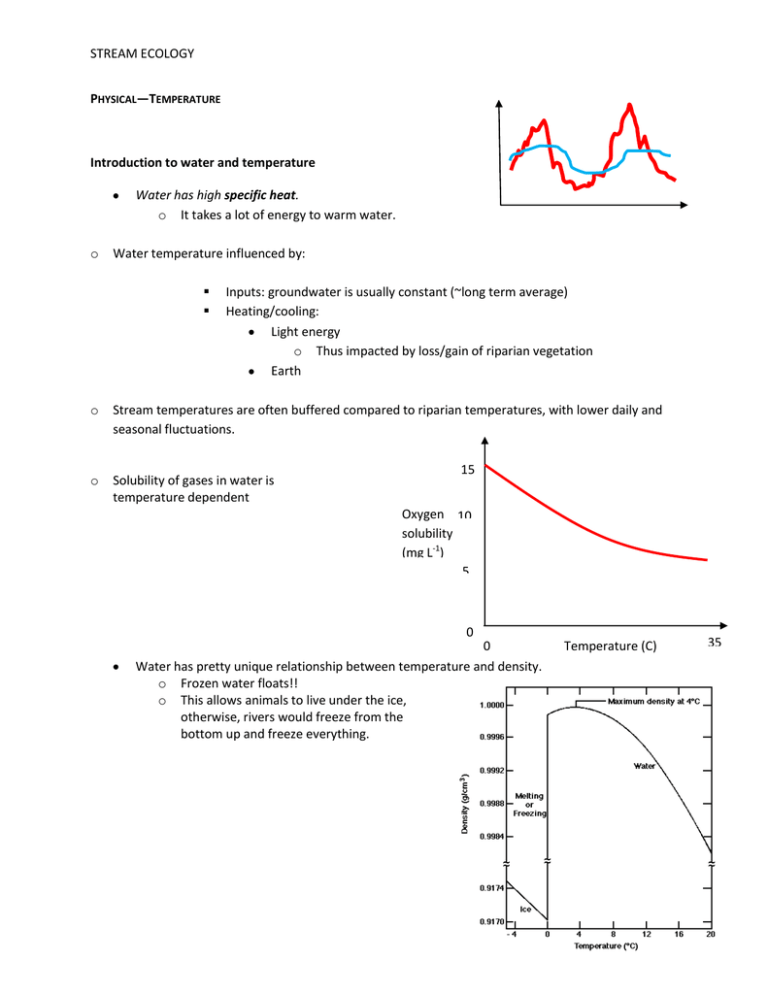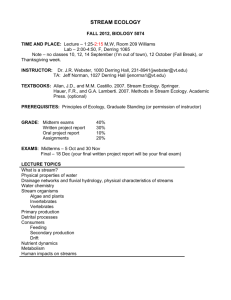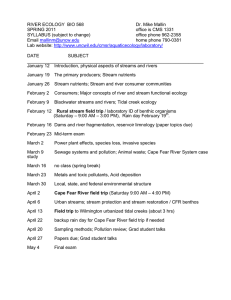STREAM ECOLOGY o Water temperature influenced by:
advertisement

STREAM ECOLOGY PHYSICAL—TEMPERATURE Introduction to water and temperature Water has high specific heat. o It takes a lot of energy to warm water. o Water temperature influenced by: Inputs: groundwater is usually constant (~long term average) Heating/cooling: Light energy o Thus impacted by loss/gain of riparian vegetation Earth o Stream temperatures are often buffered compared to riparian temperatures, with lower daily and seasonal fluctuations. o Solubility of gases in water is temperature dependent 15 Oxygen 10 solubility (mg L-1) 5 0 0 Water has pretty unique relationship between temperature and density. o Frozen water floats!! o This allows animals to live under the ice, otherwise, rivers would freeze from the bottom up and freeze everything. Temperature (C) 35 STREAM ECOLOGY Temperature variation across time Diel patterns—usually have some daily fluctuations but varies depending on where in watershed. Groundwater Solar radiation Large and very buffered From Vannote and Sweeny 1980 Seasonal patterns of water temperature depend on water source. Not surprisingly, rivers at higher latitudes are colder. But still lots of variation at fine spatial scales depending on the source of water and exposure to sun, etc. Bioenergetics: Most animals in streams are ectothermic (“cold-blooded”). Stream temperature thus changes the rates of consumption, growth. The energetic demands of fishes change systematically as a function of temperature. In general, growth increases gradually as temperature increases, and then decreases dramatically at a critical temperature. Stream animals thus have behaviors and life-histories that are adapted to spatial and temporal dynamics in temperatures. o E.g, Armstrong et al. (2010). Coho salmon in streams. STREAM ECOLOGY Climate change Annual mean river temperatures are increasing around 0.1 to 0.8 degrees C per decade. This also dramatically changes flow regimes o earlier snowmelt o more rain dominated hydrographs FRASER RIVER SOCKEYE.--Example of climate change, temperature increases, and consequences Climate change and mortality During years with warmer water temperature, more fish die on migration upriver 1995-present—Early migration phenomenon Late run fish now are migrating earlier They are now exposed to higher temperatures Why? This might be an evolutionary trap—where past evolutionary forces no longer apply today Local adaptation in Fraser sockeye There are numerous locally adapted sockeye populations in the Fraser Eliason et al. 2011 did a physiological study of sockeye populations Local physiological adaptations to migrations and water temperature Future adaptation to climate change Adaptive potential will depend on: 1. 2. 3. 4. Strong directional selection Genetic variation Heritability of traits Plus, whether traits will evolve or come up to hard physiological blocks. . . Study by Reed et al. 2011 predicted evolution of migration of sockeye from now until 2100 This study used a model to make a prediction on evolution and population consequences Predicted that evolution may be able to keep up with climate change o But great uncertainty and depends on above conditions



